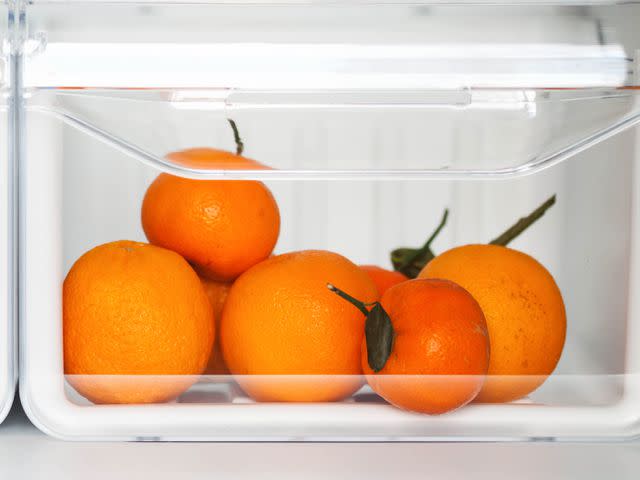Should Oranges Be Refrigerated?
Here's everything you need to know about where to store your oranges for the longest shelf life.
Sweet and juicy, brightly acidic oranges are one of our favorite fruits. Available year-round, oranges are high in vitamin C and also enjoy a long shelf life—if you know the proper way to store them.
Whether squeezed into freshly-made orange juice in the morning, added to salads, or eaten on their own, oranges are a low-calorie fruit readily available around much of the world. There are so many citrus recipes and tips for cooking with citrus that it’s worth knowing how to store the fruit so you always have some on hand.
We typically eat sweet oranges, and there are several different varieties of the sweet orange that are great as a snack or used in recipes: Tangerines, Valencia, Clementines, Mandarin, Sevilla, Cara Cara, and Navel. Oranges, regardless of the specific type, are best kept refrigerated. Read on for more tips of how to properly store oranges to maximize their shelf life.
Factors Influencing The Shelf Life of Oranges
To prolong the freshness of this classic citrus fruit, store oranges in your refrigerator. Oranges purchased by the bag will often come in a mesh bag which can be placed directly in the crisper drawer of your fridge. The mesh bag allows air to flow and help maintain oranges’ freshness.
Oranges do best in a low humidity environment, so be sure to check your fridge’s drawer settings. If you only have one crisper or both your drawers are chock-full of vegetables that require high humidity (typically vegetables prone to wilting), simply place oranges in the main part of your refrigerator. They’ll do better on their own on one of the main shelves and stay fresh longer than if made to hang out with the kale, asparagus, and other leafy greens.
To Refrigerate Or Not: Unpacking The Debate
Oranges prefer a cool, dark place. This makes the refrigerator an ideal place for storing oranges. Sunlight and warm temperatures will speed the ripening of oranges, decreasing their shelf life. This means that oranges left on the kitchen counter or in a fruit bowl on your dining table won’t last as long as whole, refrigerated oranges.
Many people also prefer the taste of oranges when they’re cool or cold straight out of the fridge as opposed to oranges that have become warm after being stored outside the fridge.
If you have a full fridge or simply don’t prefer a chilled orange, you can leave oranges on the counter for up to five days for best results. But if you choose this method of storage, be sure to leave them on countertop space not in direct sunlight. A dark or shady part of your kitchen is best if you’re not opting for fridge storage.
RELATED: How To Clean Fruits And Vegetables So They Are Safe To Eat

Getty Images
How Refrigeration Impacts Shelf Life
Oranges stored in the fridge in a low-humidity crisper drawer can stay fresh for up to a month, sometimes longer. The ideal temperature for oranges is 41 to 42 degrees Fahrenheit.
Oranges can also be frozen. While you can store whole oranges, it’s not the best method. You’re better off slicing the oranges before freezing. Place sliced fruit on a single layer on a tray lined with parchment paper or tinfoil. Once they are completely frozen, transfer to a plastic freezer bag or container with a tightly-sealed lid and keep frozen for up to four months. The taste and nutritional value may decrease slightly, but a thawed orange is perfectly safe to eat and can be quite delicious.
The bottom line is that you’ll prolong the shelf life of oranges if you refrigerate them. Any oranges left on the counter for several days should be transferred to the fridge if not eaten.
Cut oranges or orange slices should also be kept in the fridge. Don’t count on getting more than a week or so out of the cut fruit stored in a plastic bag or other container with a tightly-sealed lid though as once the fruit is cut its exposure to air impacts its shelf life.
For more Southern Living news, make sure to sign up for our newsletter!
Read the original article on Southern Living.

